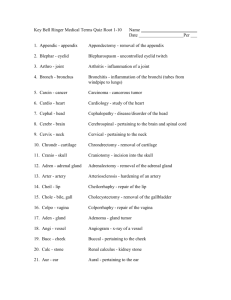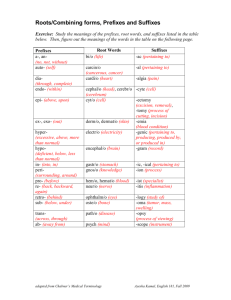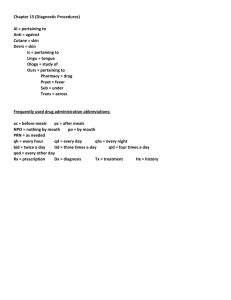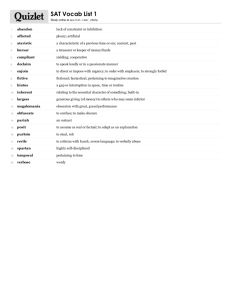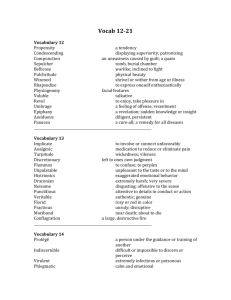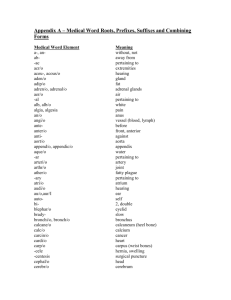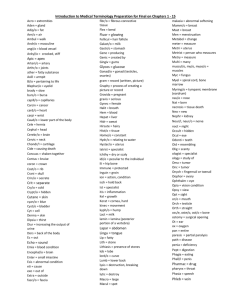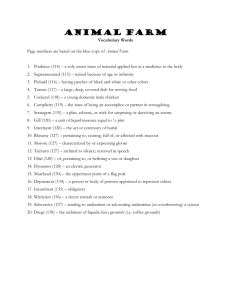Medical Terminology: Word Parts
advertisement
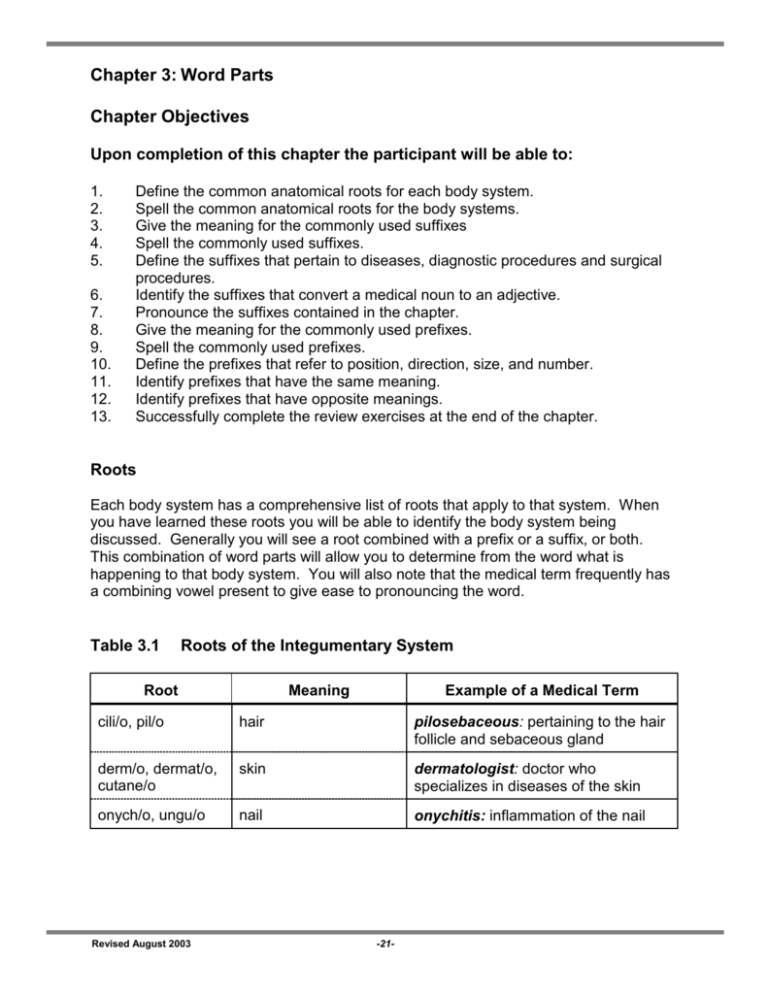
Chapter 3: Word Parts Chapter Objectives Upon completion of this chapter the participant will be able to: 1. 2. 3. 4. 5. 6. 7. 8. 9. 10. 11. 12. 13. Define the common anatomical roots for each body system. Spell the common anatomical roots for the body systems. Give the meaning for the commonly used suffixes Spell the commonly used suffixes. Define the suffixes that pertain to diseases, diagnostic procedures and surgical procedures. Identify the suffixes that convert a medical noun to an adjective. Pronounce the suffixes contained in the chapter. Give the meaning for the commonly used prefixes. Spell the commonly used prefixes. Define the prefixes that refer to position, direction, size, and number. Identify prefixes that have the same meaning. Identify prefixes that have opposite meanings. Successfully complete the review exercises at the end of the chapter. Roots Each body system has a comprehensive list of roots that apply to that system. When you have learned these roots you will be able to identify the body system being discussed. Generally you will see a root combined with a prefix or a suffix, or both. This combination of word parts will allow you to determine from the word what is happening to that body system. You will also note that the medical term frequently has a combining vowel present to give ease to pronouncing the word. Table 3.1 Roots of the Integumentary System Root Meaning Example of a Medical Term cili/o, pil/o hair pilosebaceous: pertaining to the hair follicle and sebaceous gland derm/o, dermat/o, cutane/o skin dermatologist: doctor who specializes in diseases of the skin onych/o, ungu/o nail onychitis: inflammation of the nail Revised August 2003 -21- Table 3.2 Roots of the Nervous System Root Meaning Example of Medical Term cerebr/o, encephal/o brain cerebral: pertaining to the brain myel/o spinal cord myelogram: X-Ray of the spinal cord neur/o nerve neuritis: inflammation of a nerve psych/o mind psychosis: condition of the mind mening/o, meningi/o meninges meningitis: inflammation of the meninges corti/o cortex cortical: pertaining to the cortex Table 3.3 Roots of the Musculoskeletal System Root Meaning Example of a Medical Term arthr/o joint arthrogram: X-Ray picture of a joint chondr/o cartilage chondrectomy: surgical removal of a cartilage crani/o skull craniotomy: surgical opening into the skull cost/o rib costectomy; surgical removal of a rib my/o, muscul/o muscle myopathy: disease of the muscle myel/o marrow myelopathy: disease of bone marrow oste/o bone osteoplasty: surgical repair of a bone pelv/o pelvis pelvimetry: measurement of the dimensions of the pelvis spin/o spine spinal: pertaining to the spine tend/o, tendin/o, ten/o tendon tenolysis: to free a tendon from adhesions thorac/o chest thoracotomy: surgical opening into the chest vertebr/o, spondyl/o vertebra spondylosis: degeneration of vertebra Revised August 2003 -22- Table 3.4 Roots of the Sensory System Term Meaning Example of a Medical Term blephar/o eyelid blepharitis: inflammation of the eyelid ophthalm/o, opt/o ocul/o, optic/o eye ocular: pertaining to the eye ot/o, audit/o, audi/o ear otoplasty: surgical repair of the ear Table 3.5 Roots of the Digestive System Term Meaning Example of a Medical Term abdomin/o abdomen abdominal: pertaining to the abdomen cheil/o, labi/o lips cheiloplasty: surgical repair of the lip chol/e cyst/o gall bladder cholecystectomy: surgical removal of gall bladder col/o, colon/o large intestine, colon colonoscopy: examination of the large intestine using a scope enter/o small intestine enteritis: inflammation of the small intestine esophag/o esophagus esophagitis: inflammation of esophagus gastr/o stomach gastric: pertaining to the stomach gingiv/o gums gingivitis: inflammation of the gums gloss/o, lingu/o tongue glossal: pertaining to the tongue hepat/o liver hepatic: pertaining to the liver lapar/o abdomen laparotomy: surgical opening into the abdomen odont/o, dent/o, dent/i teeth odontal: pertaining to the teeth or/o, stomat/o mouth stomatitis: inflammation of the mouth pancreat/o pancreas pancreatitis: inflammation of the pancreas pharyng/o throat, pharynx pharyngeal: pertaining to the pharynx rect/o rectum rectal: pertaining to the rectum splen/o spleen splenectomy: surgical removal of spleen Revised August 2003 -23- Table 3.6 Roots of the Urinary System Root Meaning Example of a Medical Term cyst/o bladder cystogram: X-Ray picture of the bladder pyel/o renal pelvis pyelitis: inflammation of the renal pelvis ren/o, nephr/o kidneys renal: pertaining to the kidneys ureter/o ureters ureteroplasty: surgical repair of a ureter urethr/o urethra urethropexy: surgical fixation of the urethra Table 3.7 Roots of the Circulatory System Root Meaning Example of a Medical Term angi/o, vascul/o, vas/o vessel angiogram: X-Ray study of blood vessels after a dye is injected arteri/o artery arterionecrosis: necrosis of an artery cardi/o heart cardiology: study of diseases of the heart hem/o, hemat/o blood hematologist: physician who specializes in diseases of the blood ven/o, phleb/o vein phlebotomy: surgical opening into a vein Table 3.8 Roots of the Endocrine System Root Meaning Example of a Medical Term aden/o gland adenectomy: surgical removal of gland adren/o, adrenal/o adrenal gland adrenalitis: inflammation of adrenal gland parathyroid/o, parathyr/o parathyroid gland parathyroidectomy: surgical removal of the parathyroid gland pituit/o pituitary gland pituitism: disorder if the pituitary gland thyroid/o, thyr/o thyroid gland thyrotoxicosis: condition caused by too much thyroid hormone Revised August 2003 -24- Table 3.9 Roots of the Lymphatic and Immune Systems Root Meaning Example of a Medical Term adenoid/o adenoids adenoidectomy: surgical removal of the adenoids lymph/o lymph fluid lymphatic: pertaining to lymph fluid lymphaden/o lymph gland lymphadenitis: inflammation of a lymph gland lymphangi/o lymph vessels lymphangiogram: X-Ray picture of a lymph vessel using a dye. splen/o spleen splenectomy: surgical removal of the spleen tonsill/o tonsils tonsillectomy: surgical removal of the tonsils thym/o thymus thymectomy: surgical removal of the thymus gland Table 3.10 Roots of Respiratory System Root Meaning Example of a Medical Term alveol/o air sacs alveolar: pertaining to an air sac bronch/o, bronchi/o bronchus bronchitis: inflammation of a bronchus bronchiol/o small bronchial tubes bronchiolitis: inflammation of the small bronchial tubes laryng/o voice box, larynx laryngitis: inflammation of the voice box nas/o, rhin/o nose rhinorrhea: discharge from the nose pharyng/o throat, pharynx pharyngitis: inflammation of the throat pneum/o, pneumon/o pulmon/o, pulm/o lungs pulmonary: pertaining to the lungs thorac/o chest thoracotomy: create opening into chest trache/o windpipe, trachea tracheostomy: creation of a permanent opening in the windpipe Revised August 2003 -25- Table 3.11 Roots of the Male Reproductive System Root Meaning Example of a Medical Term andr/o male android: male like balan/o glans penis (tip of the penis) balanitis: inflammation of the glans penis epididym/o epididymis epididymitis: inflammation of the epididymis orchid/o, orch/o, orchi/o testes orchidectomy: removal of the testes phall/o penis phallitis: inflammation of the penis prostat/o prostate gland prostatectomy: surgical removal of the prostate gland test/o, testicul/o testicle testicular: pertaining to the testicle vas/o vas deferens, vessel, duct vasectomy: surgical removal of the vas deferens Table 3.12 Roots of the Female Reproductive System Root Meaning Example of a Medical Term cervic/o neck, uterus cervical: pertaining to the cervix colp/o, vagin/o vagina colposcopy: examination of the vagina using a scope gynec/o female gynecology: study of diseases of females mast/o, mamm/o breast, mammary gland mastectomy: removal of a breast nat/i birth prenatal: pertaining to before birth oophor/o, ovari/o ovary ovarian: pertaining to an ovary salping/o fallopian tubes salpingitis: inflammation of fallopian tube uter/o, hyster/o, metr/o uterus hysterectomy: surgical removal of uterus vulv/o vulva vulvitis: inflammation of the vulva Revised August 2003 -26- Table 3.13 Body as a Whole Roots Roots Meaning Example of a Medical Term adip/o, lip/o, steat/o fat, lipid lipoma: a tumor made up of fat cells axill/o armpit axillary: pertaining to the armpit bi/o pertaining to life biology: the study of life cephal/o, head cephalic: pertaining to the head cyt/o cell cytology: study of the cell hist/o, histi/o tissue histology: pertaining to the study of tissue viscer/o internal organs, viscera visceral: pertaining to internal organs As discussed in the previous chapters, when analyzing a medical term the first part of the word to analyze is the suffix. The most common suffixes used in medical terms can be grouped into four sections: procedures, conditions, diagnostics, and diseases. Table 3.14 Suffixes That Indicate A “Condition” Suffix Example of a medical term Meaning -algia, -dynia pain otalgia, otodynia: pain in the ear or an earache arthrodynia: joint pain -cele hernia (protrusion of an organ through a body part) cystocele: hernia or protrusion of the bladder -ectasis, -ectasia dilation, stretching angiectasis: dilation of a vessel -emesis vomiting hematemesis: vomiting of blood -emia blood condition, blood ischemia: hold back of blood to an area -iasis abnormal condition, pathologic state cholecystolithiasis: condition of stones in the gall bladder -itis inflammation gastritis: inflammation of stomach -lith stone, calculi cholelith: bile stones, gall stones Revised August 2003 -27- Suffix Example of a medical term Meaning -lysis destruction, breakdown hemolysis: breakdown of blood -malacia abnormal softening osteomalacia: softening of bone -megaly enlargement, large, great cardiomegaly: enlarged heart -oma tumor, neoplasm adenoma: tumor of a gland -osis, ia state, abnormal condition, disease nephrosis: abnormal condition of the kidney prognosis: prediction of disease outcome pneumonia: condition of the lungs -pathy disease myopathy: disease of the muscle -penia decrease, deficiency cytopenia: deficiency in cells -phob irrational fear acrophobia: condition where there is a fear of heights -plegia paralysis quadriplegia: paralysis of four limbs -ptosis drooping, sagging, prolapse nephroptosis: drooping kidney -ptysis spitting hemoptysis: spitting up blood -rrhage, -rrhagia bursting forth hemorrhage: bursting forth of blood, bleeding -rrhea flow, discharge rhinorrhea: discharge from the nose -rrhexis rupture splenorrhexis: ruptured spleen -sclerosis hardening, hardness arteriosclerosis: hardening of the arteries -spasm sudden involuntary contractions, tightening blepharospasm: sudden contraction of the eyelid -stenosis narrowing, tightening arteriostenosis: narrowing of the arteries -y, -ion process neuropathy: disease process of the nerve Revised August 2003 -28- Table 3.15 Suffixes Used To Indicate “Diagnostic & Surgical Procedures” Suffix Meaning Example of a Medical Term -centesis surgical puncture to remove fluid thoracocentesis: surgical puncture into the chest wall to remove fluid -desis surgical fusion, bind, tie together arthrodesis: surgical fusion of a joint -ectomy cutting out, excision, surgical removal tonsillectomy: excision of the tonsils -graphy process of recording; a picture or record myelography: producing an image of the spinal cord -gram tracing, picture record electroencephalogram: record of the electrical activity of the brain -graph instrument used to record or create a picture electroencephalograph: instrument used to record the electrical activity of the brain -metry to measure pelvimetry: measurement of pelvis -meter instrument used to measure craniometer: instrument used to measure the skull -opsy, -opsis, -opsia view of, vision biopsy: removal of a piece of living tissue for examination -pexy surgical fixation, to put in place nephropexy: surgical fixation of kidney -plasty surgical repair arthroplasty: surgical repair of a joint -rrhaphy suture splenorrhaphy: suturing of spleen -scope instrument for visual examination bronchoscope: instrument used to examine the bronchus -scopy examination using a scope bronchoscopy: examine the bronchus -stasis controlling, stopping hemostasis: stoppage of blood -stomy create a permanent opening tracheostomy: create a permanent opening into the trachea -tome instrument used to cut osteotome: instrument used to cut bone -tomy surgical incision, cutting osteotomy: surgical incision into a bone Revised August 2003 using a scope -29- Table 3.16 General Suffixes Suffix Meaning Example of a Medical Term - blast immature, growing erythroblast: immature red blood cell -cyte cell leukocyte: white blood cell -er, -or, -ician, -logist, -ist specialist in the study of cardiologist: heart specialist -logy study of physiology: study of function -phagia eating, swallowing dysphagia: difficulty swallowing -phasia speech, speak aphasia: unable to speak -plasia formation, development, growth hyperplasia: excessive formation -pnea breathing dyspnea: difficulty breathing -poiesis production, formation hematopoiesis: formation of blood -trophy development, growth, nourishment hypertrophy: increase in the development of a part of the body -uria urine, urination anuria: absence of urine -genous, -genic, -genesis producing, forming carcinogenic: cancer producing -oid resembling, like mucoid: resembling mucus -ole, -ule small venule: small vein -ac,-al, -ar, -ary, -eal, -ic, -ior, -ose, -ous, -tic, -ine pertaining to gastric: pertaining to the stomach Prefixes Prefixes tell us how, why, where, when, how much, how many, what position, what direction. Many prefixes are paired with another prefix that has just the opposite meaning. Revised August 2003 -30- Table 3.17 Prefixes Referring to Direction and Position Prefix Meaning Example of a Medical Term ab-, abs- away from abduction: drawing away from ad- toward, in direction of adduction: drawing toward ante- before, forward antenatal: pertaining to before birth circum- around, about circumduction: process of putting a part through circular motion dia- through, complete, between diagnosis: differentiating between one disease and another ecto-, e-, ex-, exo-, extra- outside, out, outward ectogenous: produced from outside excision: process of cutting out endo- within, inside endoscope: instrument used to look inside the body epi- upon, on, above epicardium: above the heart eso- inward, within esotropia: turning inward of the eye hyper-, supra excessive, above, increased hyperplasia: excessive formation suprarenal: pertaining to above the kidney hypo- decreased, below, under, deficient hypogastric: pertaining to below the stomach in- in, into, not, without incision: process of cutting into infra-, sub- below, beneath, inferior to, less, under infracostal: pertaining to below ribs subdermal: pertaining to under the skin inter- between, among intercellular: pertaining to between the cells intra- within, into, inside intracranial: pertaining to within the skull meta-, ultra- beyond, change, behind metaplasia: change in formation para- beside, near, apart from paranasal: pertaining to near the nose peri- around, surrounding perineuritis: inflammation around nerve Revised August 2003 -31- Prefix Meaning Example of a Medical Term post- after, behind postpartum: after delivery of a baby pre- before, in front of prenatal: pertaining to before birth pro- before process: series of things before an event concludes retro-, retr/o back of, backward, behind retroversion: tipping back of an organ trans-, per- across, through transection: process of cutting across percutaneous: pertaining to through the skin Table 3.18 Negative Prefixes Prefix Meaning Example of a Medical Term anti-, contra- counter, against antibiotic: pertaining to against life contralateral: pertaining to the opposite side a-, an- no, not, lack of, without anemia: lack of (red) blood cells in-, ir-, im- not, in, into, without indigestible: not capable of digestion Table 3.19 Prefixes Referring to Numbers Prefix Meaning Example of a Medical Term bi-, di- two, double, twice bilateral: pertaining to both sides hemi-, semi- half, partial hemiplegia: paralysis of half of body mono-, uni- one unilateral: pertaining to one side multi-, poly- many, much polyadenoma: tumor of many glands oligo- scant, few oliguria: scant urine quadri- four quadriplegia: paralysis of four limbs tri- three tricuspid: three cusps or projections Revised August 2003 -32- Table 3.20 Miscellaneous Prefixes Prefix Meaning Example of a Medical Term ana- up anadipsia: excessive thirst auto- self autograph: graph taken from one part of the body and placed on another area of the same body brady- slow bradycardia: slow heart rate dys- bad, abnormal, difficult, painful dysplasia: abnormal development macro- large macrocephalic: pertaining to a large head mal- bad, poor, evil malaise: feeling poor micro- small microcytic: pertaining to small cells neo- new neoplasm: new development pan- all, entire, every pancarditis: inflammation of all layers of the heart syn-, sym- together, with, joined synarthrotic: pertaining to a joint where the bones are joined tachy- fast, rapid tachycardia: pertaining to a fast heart rate Revised August 2003 -33-
